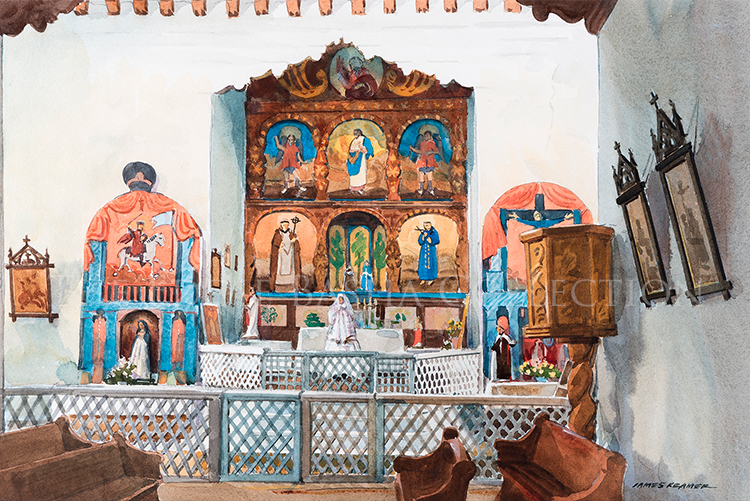James Kramer
(b.1927)

Sanctuary, Las Trampas Church
Artist: James Kramer (b.1927)
Description: Watercolor | Image Size: 12”h x 18”w; Framed Size: 21 ¾”h x 27 ¾”wpainting
With his architect’s eye, James Kramer is interested in the juxtaposition of shapes and forms. With his artist’s eye, he has a flair for color, tone, and shading. In this painting of the San José de Gracia de Las Trampas mission church sanctuary in a beautiful mountain valley south of Taos, New Mexico, Kramer employs both his architecture and artistic training. The painting is full of the bold colors that are so often evident in New Mexico. Kramer has focused on the many shapes and forms that are found in the sanctuary, such as arched niches and paintings that tilt away from the wall they are hung on. His use of color and light bring a sense of serenity, but also a vibrant feeling to this sacred space.
San José de Gracia is situated on the original town plaza. The church was completed in 1780 and is considered to be one of the best preserved examples of Spanish Colonial Mission architecture in New Mexico. San José de Gracia de Las Trampas is still an active parish church and was fully restored in the 1970s.
 Watercolor | Image Size: 12”h x 18”w; Framed Size: 21 ¾”h x 27 ¾”w
Watercolor | Image Size: 12”h x 18”w; Framed Size: 21 ¾”h x 27 ¾”wWith his architect’s eye, James Kramer is interested in the juxtaposition of shapes and forms. With his artist’s eye, he has a flair for color, tone, and shading. In this painting of the San José de Gracia de Las Trampas mission church sanctuary in a beautiful mountain valley south of Taos, New Mexico, Kramer employs both his architecture and artistic training. The painting is full of the bold colors that are so often evident in New Mexico. Kramer has focused on the many shapes and forms that are found in the sanctuary, such as arched niches and paintings that tilt away from the wall they are hung on. His use of color and light bring a sense of serenity, but also a vibrant feeling to this sacred space.
San José de Gracia is situated on the original town plaza. The church was completed in 1780 and is considered to be one of the best preserved examples of Spanish Colonial Mission architecture in New Mexico. San José de Gracia de Las Trampas is still an active parish church and was fully restored in the 1970s.
Sanctuary, Las Trampas Church
Artist: James Kramer (b.1927)
Description:
Watercolor | Image Size: 12”h x 18”w; Framed Size: 21 ¾”h x 27 ¾”w
With his architect’s eye, James Kramer is interested in the juxtaposition of shapes and forms. With his artist’s eye, he has a flair for color, tone, and shading. In this painting of the San José de Gracia de Las Trampas mission church sanctuary in a beautiful mountain valley south of Taos, New Mexico, Kramer employs both his architecture and artistic training. The painting is full of the bold colors that are so often evident in New Mexico. Kramer has focused on the many shapes and forms that are found in the sanctuary, such as arched niches and paintings that tilt away from the wall they are hung on. His use of color and light bring a sense of serenity, but also a vibrant feeling to this sacred space.
San José de Gracia is situated on the original town plaza. The church was completed in 1780 and is considered to be one of the best preserved examples of Spanish Colonial Mission architecture in New Mexico. San José de Gracia de Las Trampas is still an active parish church and was fully restored in the 1970s.
paintingWith his architect’s eye, James Kramer is interested in the juxtaposition of shapes and forms. With his artist’s eye, he has a flair for color, tone, and shading. In this painting of the San José de Gracia de Las Trampas mission church sanctuary in a beautiful mountain valley south of Taos, New Mexico, Kramer employs both his architecture and artistic training. The painting is full of the bold colors that are so often evident in New Mexico. Kramer has focused on the many shapes and forms that are found in the sanctuary, such as arched niches and paintings that tilt away from the wall they are hung on. His use of color and light bring a sense of serenity, but also a vibrant feeling to this sacred space.
San José de Gracia is situated on the original town plaza. The church was completed in 1780 and is considered to be one of the best preserved examples of Spanish Colonial Mission architecture in New Mexico. San José de Gracia de Las Trampas is still an active parish church and was fully restored in the 1970s.